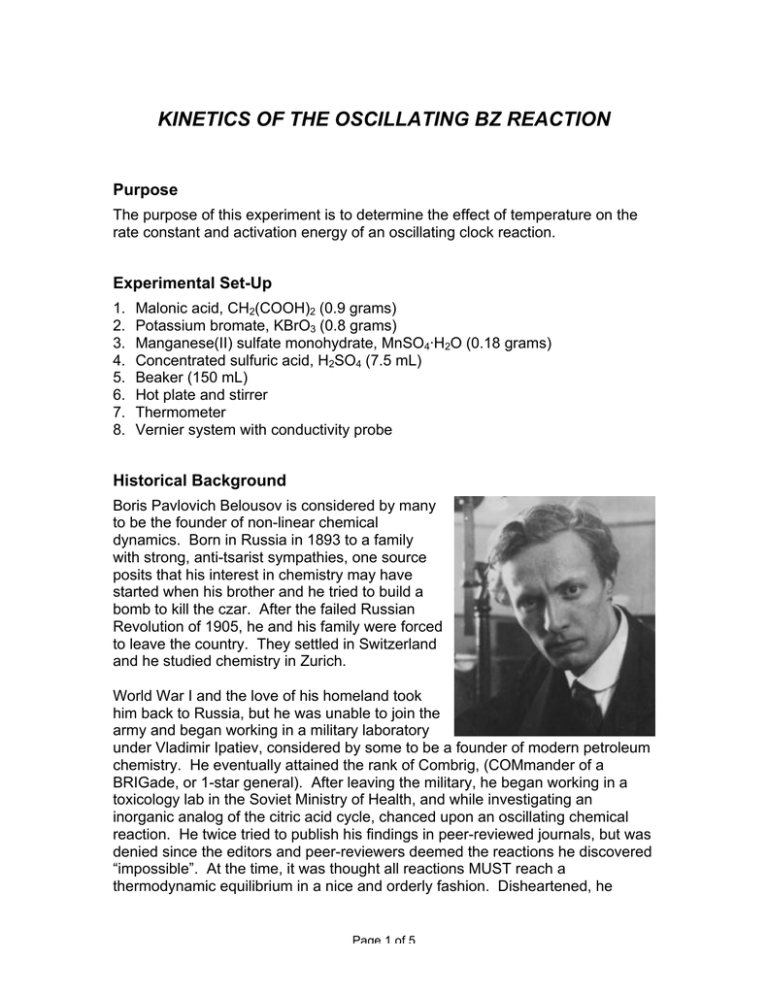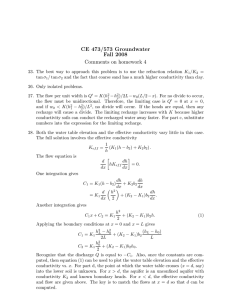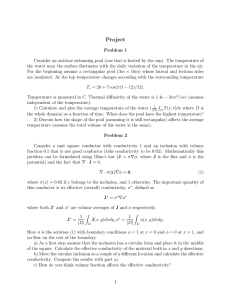KINETICS OF THE OSCILLATING BZ REACTION Purpose
advertisement

KINETICS OF THE OSCILLATING BZ REACTION Purpose The purpose of this experiment is to determine the effect of temperature on the rate constant and activation energy of an oscillating clock reaction. Experimental Set-Up 1. 2. 3. 4. 5. 6. 7. 8. Malonic acid, CH2(COOH)2 (0.9 grams) Potassium bromate, KBrO3 (0.8 grams) Manganese(II) sulfate monohydrate, MnSO4·H2O (0.18 grams) Concentrated sulfuric acid, H2SO4 (7.5 mL) Beaker (150 mL) Hot plate and stirrer Thermometer Vernier system with conductivity probe Historical Background Boris Pavlovich Belousov is considered by many to be the founder of non-linear chemical dynamics. Born in Russia in 1893 to a family with strong, anti-tsarist sympathies, one source posits that his interest in chemistry may have started when his brother and he tried to build a bomb to kill the czar. After the failed Russian Revolution of 1905, he and his family were forced to leave the country. They settled in Switzerland and he studied chemistry in Zurich. World War I and the love of his homeland took him back to Russia, but he was unable to join the army and began working in a military laboratory under Vladimir Ipatiev, considered by some to be a founder of modern petroleum chemistry. He eventually attained the rank of Combrig, (COMmander of a BRIGade, or 1-star general). After leaving the military, he began working in a toxicology lab in the Soviet Ministry of Health, and while investigating an inorganic analog of the citric acid cycle, chanced upon an oscillating chemical reaction. He twice tried to publish his findings in peer-reviewed journals, but was denied since the editors and peer-reviewers deemed the reactions he discovered “impossible”. At the time, it was thought all reactions MUST reach a thermodynamic equilibrium in a nice and orderly fashion. Disheartened, he Page 1 of 5 published his findings in an obscure, non-peer-reviewed assay of radiobiology and left science forever. An acquaintance of Belousov gave the research to his graduate student, Anatol Zhabotinskii, who studied the reaction in detail, published his findings, and left the legacy we now know as the BelousovZhabotinskii, or BZ, reaction. Discussion Oscillating reactions are an interesting series of reactions that, while being extensively studied, are still not completely understood. In this experiment, you will study the BZ reaction. While numerous mechanisms have been proposed (some of which include over twenty different reactions occurring simultaneously 1), a model, called the Oregonator (since it was developed at the University of Oregon), presents a simplified mechanism for the BZ reaction (see Steps 1-5 below). Note that the reactions in the mechanism are not balanced, but do illustrate the main components of the overall mechanism. Step 1: Step 2: Step 3: Step 4: Step 5: BrO3- + Br- _ HBrO2 + HBrO HBrO2 + Br- _ 2 HBrO BrO3- + HBrO2 _ 2 HBrO2 + 2 Mn3+ 2 HBrO2 _ HBrO + BrO32 Mn3+ _ Br- The bromate ions (BrO3-) and the bromide ions (Br-) ions act as catalysts, and since they are products of the overall reaction as well, the reaction is said to be autocatalytic. The version of the BZ reaction that you will be studying does not include the bromide ion as a starting reagent; rather it will be formed in-situ via reactions between bromate, manganese and malonic acid. In this experiment, you should observe the solution oscillating between an amber color and colorless. The amber color is due to the formation of bromine via the reaction: BrO3- + 5 Br- + 6 H+ _ 3 Br2 + 3 H2O and the disappearance of the amber color is due to the consumption of bromine via reaction with malonic acid: Br2 + CH2(COOH)2 _ BrCH(COOH)2 + Br- + H+ You will measure the conductivity of the solution during the reaction and use the data to determine the apparent rate constant of the overall reaction at two different temperatures. Note that you will not use the conductivity values in any calculations; they are simply a convenient way to monitor the time dependence of the reaction. From this, you will then prepare an Arrhenius plot to determine the overall activation energy of the reaction. The apparent rate reaction is given by: Page 2 of 5 k= 1 [CH 2 (COOH ) 2 ]t =0 ∗ t (1) where [CH2(COOH)2]t=0 = malonic acid concentration in molarity at the beginning of the reaction and t = time in seconds. Rate constants vary with temperature as described by the Arrhenius Equation: k = Ae − Ea RT (2) which can be rearranged into a linear equation: ln k = − Ea + ln A RT (3) Plotting ln k versus 1/T (T in Kelvin) will yield a straight line that will have a slope of -Ea/R. Solving for the activation energy is a simple matter. You will determine the activation energy at three different times after you mix the reactants. The first value of t will be the time it takes the first oscillation to appear. The second value of t will be the time between the first two oscillations. The third value of t will be the time between two oscillations near the end of the reactions (just before 20 minutes; vide infra). Procedure 1. Add 75 mL of deionized water to a 150 mL beaker, begin stirring with a stir bar, and then slowly add 7.5 mL of concentrated sulfuric acid to the water. The solution should be stirred continuously until data collection is completed. 2. Place the conductivity probe (with the Vernier set-up) in the solution and begin collecting conductivity data as a function of time. The probe does not need to be calibrated, but the instrument response time needs to be set to the smallest possible value. 3. Add 0.9 grams of solid malonic acid to the above solution and allow it to dissolve. 4. Add 0.8 grams of solid potassium bromate to the above solution and allow it to dissolve. 5. Add 0.18 grams of solid manganese sulfate to the above solution. You should see the conductivity spike, and then the reaction should start to oscillate between an amber color and colorless. Page 3 of 5 6. Collect conductivity data for about 20 minutes (save your data before clearing it for the next run). Monitor the average temperature of the solution during the reaction. Note the times corresponding to a color change and the relative conductivity values (higher or lower) at those times. 7. Repeat the experiment at an elevated temperature (~50 °C) using a hot plate. It is useful to start heating the water before you finish the room temperature experiment. Lab Write-Up Requirements 1. Report the three rate constants at each of the two temperatures. The third rate constant at each temperature is calculated assuming the concentration of malonic acid at the end of the reaction is the same as the initial concentration. What effect does this have on the value of the third rate constant? Repeat the calculation of the third rate constant with some arbitrary value less than the initial concentration of malonic acid (say 1/3rd the initial value). What effect does this have on the rate constant and the activation energy? 2. Prepare an Arrhenius plot (ln k vs. 1/T) for each the four different rate constants (using both the initial concentration of malonic acid and the arbitrary value - four total plots). 3. In a table, report the four activation energies determined from the Arrhenius plots. How do the values compare to each other? How does the activation energy based on the arbitrary malonic acid concentration compare to the other values? 4. Is it reasonable to use the malonic acid concentration for the calculation of the rate constant? Why or why not? Is it reasonable to assume there is only one activation energy for the overall reaction? Why or why not? 5. How do the color changes of the solution relate to the time and conductivity values? Which species are probably dominant at high conductivity, and which are probably dominant at low conductivity? Page 4 of 5 References Shakhashiri, B., Chemical Demonstrations, Vol. 2, University of Wisconsin Press, Madison Wisconsin (1985). Pre-Lab Question What effect does an increase in temperature have on reaction rate? What is happening at the molecular level to produce this effect? Page 5 of 5




